33. Long shots at school
I shifted the phone to my other hand and wrote as Darrell Holland dictated the address. “Get there the night before. Bring your rifle and 300 rounds of ammo.”
Highway 42 snaked through the southern Coast Range over a low pass and onto the South Fork of the Coquille. Powers, Oregon was a dot on the map upstream; I stayed with the river into Myrtle Point and checked into the only motel. The proprietor’s small-town hospitality was genuine. He told me there were lots of elk in the hills and that logging strictures had squeezed local businesses. From the office we watched the sun’s last light on Coquille backwaters—a glistening apron below the forest. “It’s still a pretty place.”
Next morning, after threading timber on a twisty macadam road, I came to Powers and a clapboard building—a Rotarian lodge that could have been a church, or a church that had once been a schoolhouse.

Tactical rifles chambered for long-range rounds are typically heavy and have many adjustments.
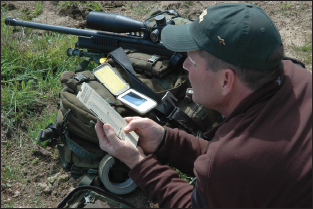
Notebooks and the Mil Dot Master are required on the line at Darrell Holland’s shooting school.
“Safety first,” barked Darrell, after introductions. This long-range shooting class numbered 20 or so, including those who’d been through the course and returned to help. David Brauneis was one. Pairing up recruits in shooter-spotter teams left David with me so I could run my camera when not on the line.

Good notes help all students—especially shooters learning the vagaries of wind at distance!
Rules and procedures out of the way, Darrell launched into the contents of a three-ring notebook. I had thumbed the prodigious text, provided, with fruit bars and coffee, by Darrell’s wife Rosita, She and son Jonathan also distributed shooting gear Holland sells from his shop where Powers meets the forest.
That morning I struggled a bit. Not because the information was foreign; rather, I’d not before had to recite it. Quickly now, what’s a minute of angle? It’s not an inch at 100 yards; it’s 1.047 inch. A mil? It’s a mil-radian, but also 3.6 inches per 100 yards and 3.438 minutes of angle. What’s the formula for finding distance with a mil measurement? Uh…. “Math a little rusty, van Zwoll? Multiply target height in inches by 29. Divide the product by the number of mils.” Darrell grinned wickedly. He had this memorized. “For example: A buck measures 18 inches through the chest; 18 times 29 comes to 522. The reticle brackets that deer with 1.5 mils; 522 divided by 1.5 is 348 yards.” Simple enough.
But not everyone shoots at long range or has a scope reticle that shows mil measurements. Darrell read my mind. “You can get pretty skilled at estimating ranges out to 300, even 400 yards,” he said. “But steep country can fool your eye. So can partially hidden targets, and changing light. So even at point-blank range, you can misjudge distance.” Practice with a laser rangefinder can improve estimates. Darrell leans heavily on a rangefinding reticle because “it gives you an instant read when you’re behind the trigger. It will help you hit game farther than you ever thought possible.” He adds, however, that your first job on a hunt is to get as close as you can. “Don’t shoot long when you can shoot short.”
The best all-around reticle? Darrell had shipped me a Schmidt & Bender 3-12x50 fitted with his ART, or Advanced Reticle Technology crosswire. Tics indicate mils and minutes. But it’s straightforward and easy to use. There’s minimal clutter, so it also works for instinctive shooting. Darrell pointed out that most rangefinding reticles “don’t offer enough precision for distant targets, where bullet trajectory is very steep. Their elevation ladders won’t handle the arcs of many popular cartridges at ranges beyond 500 yards. And unlike the ART, they don’t have numerical values you can plug into mil and m.o.a. formulas.”
We finished the day on a windy saddle in the Siskiyous, one of the loveliest settings I’ve ever seen from a firing line. Then the rain came, as I should have expected even in May. We zeroed at 100 yards. I’d brought .308 ammunition from Black Hills, Federal, Hornady, Remington. Most loads featured 168-grain Sierra MatchKings or similar bullets. I included some 175-grain boat-tails, which hew closely to the same path to 400 yards but retain velocity and battle wind better at long range. My Kimber LPT shot both well.
I observed that most hunters wouldn’t carry a .308 zeroed at just 100 yards, or use match bullets.
“Actually, I’ve shot more than 100 animals with a 168-grain MatchKings,” Darrell said, hunching against the wind as I opened another box of 175-grain Black Hills Match. “They drive deeper than you’d think. And they’re accurate. The 100-yard zero is fine for most shots. I crank in elevation for long pokes.”
We shot until light ran out. By the time I’d microwaved a cup of soup back in Myrtle Point, it was 9:30. Then on to homework: Clean the rifle, read in the workbook, and practice bolt cycling 150 times.
Next morning I drove fast with the window down, listening on the blind corners for that rattle of jake brakes. Log trucks had the right of way. I arrived before 8 to Rosita’s fresh fruit bars. “Position and natural sight alignment first,” harped Holland. “Controlled breathing next, then trigger squeeze and follow-through.” He recommended the Harris bipod most of us had installed, and a toe pad he designed to support the rifle’s butt. “Squeeze it with your off-side hand to nudge the muzzle.”
Still, Holland cautioned against relying on gadgets. “A couple of data cards in one pocket and the toe pad in another is really all you need besides a good rifle and scope, and the bipod.” He had printed and laminated cards for all of us, with info specific to loads we’d brought and chronographed. My card showed a 168-grain BTHP at 2,700 fps falling nearly 20 m.o.a. at 700 yards. That’s 144 inches! Over the next 50 yards, it would drop another 20 inches! Drift from a mild 12-mph full-value breeze would amount to more than 4 feet! Obviously, a hit at extreme range without data would be the purest of luck.

A shooter adjusts a scope dial calibrated for long shooting with a 105-grain VLD bullet in a .243.
At the saddle again, we shot steel silhouettes from 200 yards out, finding yardages with the ART reticle. A Kestrel anemometer helped us gauge wind speed. “Zeroes are best established in still air,” said Darrell. “After that, you can chase drift with the windage knob, or shade. If the wind is steady and you’re firing repeatedly in a match, a dial change makes sense.” He urged me to click up to add elevation, rather than hold over, to zero the resettable knob on my Schmidt & Bender at 100 yards.
Next afternoon, we spilled more brass on the saddle, then moved to a nearby hill to test our skills at ranges exceeding 800 yards. Humbling. I found that to 400 yards my sling scores matched those from the bipod. But at extreme distances, pulse bounce gave the gongs a rest.
Each morning we gathered to plow through a new chapter in the workbook, waiting for the fog to lift and hoping like 5th-graders that we’d not bungle a response when called upon. “What’s the yardage if 7 ½ minutes of reticle brackets an elk’s chest?” “How many mils in a circle?” “When is a corrected cosine helpful?” Hoo boy. “Wayne, how many mils high would you hold to kill a deer at 400 yards if bullet drop is 30 inches?” After a long, awkward moment with my calculator, I managed a tentative: “2.18 mils high—30 inches divided by 3.438 equals 8.72, divided by 4 equals 2.18 mils.”
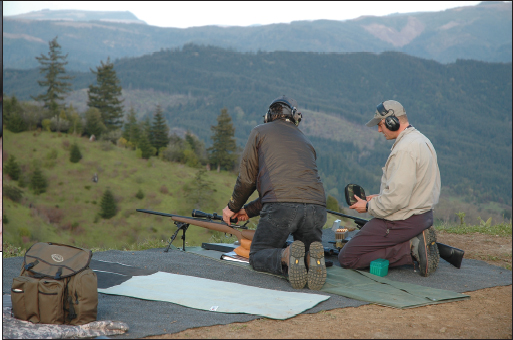
At Holland’s Shooting School, discussions turn to shots lost in frisky winds about Myrtle Point.
Each afternoon the hills tested our wind savvy. They throttled the air but also put more spin on it, vertical as well as horizontal. The breeze bent around the hills, and anemometer readings at the line differed from what distant grass told us. Cool, gray skies denied us the mirage that would have warned of pick-ups, let-offs and changes in wind direction.
“Think of wind passing over a clock,” said Darrell. “You’re at the center. A full-value wind is one that comes from right or left, 3 o’clock or 9. A half-value wind comes from 4 or 10 o’clock, quarter-value wind from 5 or 11. Give 80 percent allowance for half-value wind, 50 percent for quarter-value wind.” No matter how strong a head-wind or tail-wind, he said, it will not displace a shot laterally. The threat as wind hits you from in front or behind is a let-up. Sudden stillness often signals a change. When a 6 o’clock wind subsides, you’ll be tempted to shoot. But when that indolent breeze flips its tail, you’ll hit right or left—and wonder how a wiggle of air could have its way with a bullet unaffected by the gale that blew your hat off.
Besides our pocket calculators, we brought Mil Dot Master to the line. It’s a slide rule developed as a math shortcut, with formulas and conversions and corrections. Plug in the numbers you know—drop or drift, minutes or mils, even shot angles. Mil Dot Master delivers the information you need.
The last day was a test: Twenty shots at unspecified ranges, from a new place so you couldn’t use wind dope accumulated after four days on the saddle. No sight-in shots. You had to know the rifle and how the scope responded to adjustment. You had to use mil and/or m.o.a. scales on the reticle. You hit the steel or missed. If you dinged the heart-shaped paint in the middle you got an extra point—though recoil and/or distance hid the bullet strike so you couldn’t adjust to better your odds for a center hit with the next shot. When the last target, an extra-credit javelina hung between 500 and 600 yards, swung slowly, and the echo of a hit floated back, I slid the Kimber’s bolt open knowing I should have shot better.
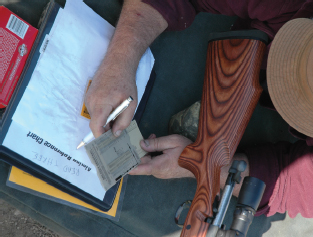
The Mil Dot Master is a bit like a slide rule for shooters – helpful even on the line.
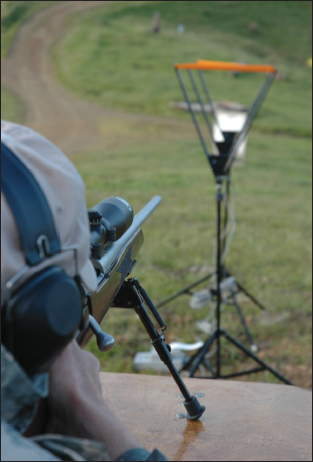
A chronograph session helps Darrell Holland correctly chart bullet paths for long-range shooters.
One of the class tallied a higher score, with a .280 Improved built by Holland. My Kimber would have cleaned the course, had I done my part.
Darrell Holland’s Shooting School is one of several courses available for would-be sharpshooters. Gunsite Academy in Arizona is another. These classes will make you a better shot. The reason: For a week, you’ll focus only on shooting. You’ll fire more cartridges than many hunters fire in a decade. You’ll iron out problems with gear and shooting positions. You’ll pick up tips from instructors and other shooters.
For example, Darrell recommended that we fire with empty lungs, that we use our trigger finger to raise the bolt handle and our thumb to return it, that for long-range practice we hang butcher paper behind the target to catch all shots. Did you know that when part of a scope field “blacks out,” your bullet will hit to the opposite side? That front and rear action screws are best torqued to 55 inch-pounds but center screws should be only snug? Darrell free-floats his barrels, with .080 forend clearance. He pillar-beds with alloy columns and gives his triggers generous over-travel. “You don’t want your finger coming up against a stop and disturbing the rifle just as it fires.”
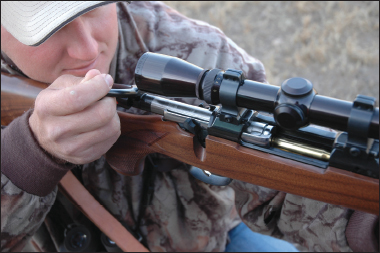
To ensure quick follow-up shots afield, practice cycling the rifle’s action every time you fire.
Common-sense tips can save you from common errors: Cycle the action quickly after each shot so you’re never caught with an empty chamber. Shoot from the lowest position possible. Let the rifle find its natural point of aim; shift your position, not your arms, to get on target. Treat each shot as the only one you’ll get. Never rest your barrel, and always pad the forend.
Holland included some insight you won’t find elsewhere unless you’re deep into Sierra’s Infinity ballistics program. For instance, you know thin air at high elevation can affect bullet flight—though lower temperatures at altitude increase density and thus offset the influence of elevation. But how much lift does thin air give a bullet? Well, a 150-grain bullet shot from a .300 Weatherby at 3,400 fps drops 34 inches at 500 yards. That’s if you’re at 1,000 feet elevation. Climb to 3,000, and you hit an inch higher. Add another inch as you approach timberline at 7,000 feet. Near Colorado’s roof, at 12,000, your bullet sinks just over 30 inches. Such differences in bullet strike (for this load ½ m.o.a. for 7,000 feet of elevation gain at 500 yards!) are tiny compared to bullet displacement from a horsed trigger.

Ruger’s Hawkeye in 6.5 Creedmoor is a lithe, light-recoiling hunting rifle with great reach.
An overlooked bonus from long-range shooting schools is their contribution to better accuracy up close, where you’re most likely to kill game. It’s easy to get sloppy from a bench at 100 yards. Snuggle into the rifle prone and try to hit a gong at unmarked range beyond a quarter mile, and you must focus. Small errors obscured by up-close shooting bring ragged groups at 500 yards—and silence from the gongs. You must shoot more carefully at long range to gain proficiency, and more often. Time behind the rifle makes you more familiar with it. Hunters who handle their rifles once a year stand out like. Saddle-bronc riders who warm a saddle that often. Neither a rifle nor a horse becomes familiar at a distance.
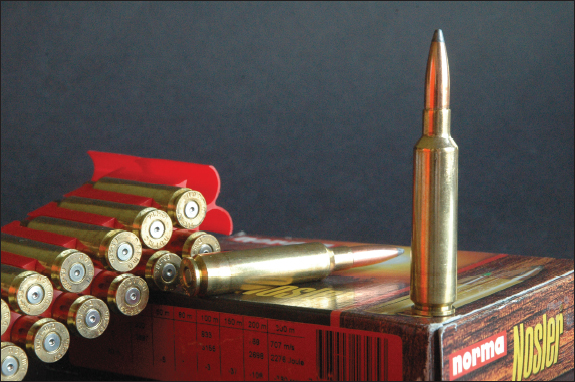
Norma loads the 6.5/284. As a wildcat, the round became the darling of 1,000-yard shooters.
To say that a hunting rifle is ill-suited to long shots is to say a gelding trained to cut cattle won’t pack elk. A rifle designed for 1,000-yard competition will perform better there than in the lodgepoles. But you can apply your hunting hardware at ranges that are long for that rifle, scope and load. Variable scopes with 3x or 4x magnification at the low end give you plenty of power for long pokes without compromising fast aim in thickets. Scopes like Leupold’s Mark 4 and Zeiss and Schmidt &Bender variables, when paired with reticles like the Holland ART, can deliver fast offhand shots or help you find and compensate for wind and gravity at distance. Barrels and bullets that excel in the thickets can also deliver fine accuracy far away.
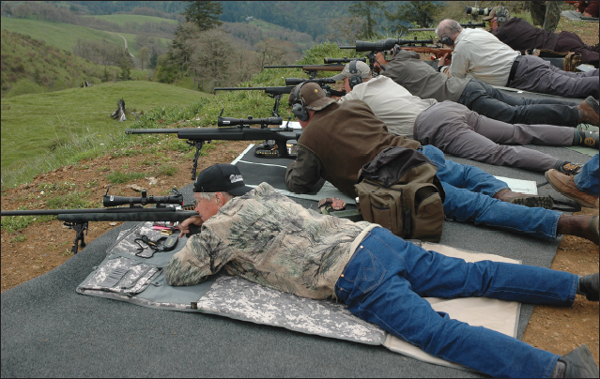
Riflemen bear down on distant targets at Darrell Holland’s shooting school in southwest Oregon.
Another benefit from Holland’s school is ranking. Few shooters can (or choose to) honestly assess their own prowess. Competition, even informal, is instructive and humbling. One unusually good shot takes you nowhere on a scoreboard; you’re compelled to fire a series of bullets, and claim the misses. You must improve aggregate scores. Long courses of fire reward consistency, which is another way to say accuracy. Checking your ego at the door is a requisite in Powers, Oregon. Because eventually you’ll bungle a shot or get the question you dread:
“OK, van Zwoll, calculate the difference in 600-yard drop caused by a 45-degree shot angle. Your .308 is zeroed at 100 yards with 168-grain MatchKings.”
“Why of course, Mr. Holland. The cosine for 45 degrees is .707, corrected cosine .300. Multiply the drop from bore by .3. Subtract the result from drop from line of sight at that distance, and divide that result by 1.047 minutes of angle. Finally, divide this number by 6, the range in hundreds of yards.… Oh, you mean the easy way. Well, you just take the straight-line distance and multiply it by .7, a handy cosine multiplier: 600 times .7 equals 420. Hold for 420 yards. For a 30-degree shot angle, the cosine multiplier is .9; for 60 degrees, it’s .5.”
Invariably I wake up at this point, as was the case decades ago the night before an algebra exam.
If math has you in a hammerlock, know that Holland’s Long Range Shooting School gives partial credit for showing up and won’t report your tenuous grasp of ballistics to anyone who thinks you never miss. Just be sure, each night, to scrub your bore until patches come out white. And when you’d rather go to bed, cycle that bolt 150 times. Follow with 150 trigger squeezes. Next day, after the fog lifts through the oaks over the Coquille, shooting mechanics must come naturally. You must be free to engineer the landing of a steeply-descending bullet on a slab of steel so far off you can eat a fruit bar before you hear it ring.
Table of contents
- Title Page
- Dedication
- Copyright
- Acknowledgments
- Foreword
- CONTENTS
- INTRODUCTION
- SECTION I: BALLISTICS IN HISTORY
- SECTION II: THE MUSCLE BEHIND THE SHOT
- SECTION III: BULLETS—THE INSIDE STORY
- SECTION IV: SPEED, ENERGY, AND ARC
- SECTION V : PUTTING BALLISTICS TO WORK
- SECTION VI: FOR LONGER REACH
- BALLISTICS TABLES FOR MODERN SPORTING RIFLES
- GLOSSARY